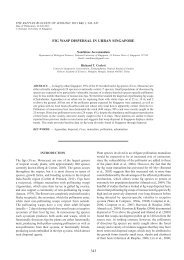1O257LF
1O257LF
1O257LF
You also want an ePaper? Increase the reach of your titles
YUMPU automatically turns print PDFs into web optimized ePapers that Google loves.
© 2010 Dinosauria International Ten Sleep Report Series No. 1<br />
Fig 21A Two of the three elements comprising the holotype of Diplodocus longus, Marsh 1878, YPM 1920. Lateral and ventral views of<br />
the mid caudal vertebra exhibit extensive, incorrectly done repair work that exaggerates the degree of sculpting on the ventral surface.<br />
Note the short prezygapophysis compared to with AMNH 223, (see Fig 29), which is a distinguishing feature separating Amphicoelias<br />
altus from Amphicoelias “brontodiplodocus”. The slight downward position of the processes on the chevron indicates that it belongs close<br />
to the forked series, and its location would have been more anterior than the probable position of the caudal vertebra.<br />
Fig 21B Two complete caudal vertebrae, from the same mid section belonging to the DQ-BS tail, displaying different depth and<br />
configuration on the ventral side, right lateral (top left) and left ventral (bottom left) views. Important feature to note is the deep<br />
sculptural configuration in #403, which is exaggerated due to compression during fossilization. 447A on the other hand, is shallow by<br />
comparison. If these caudal elements were found separately and unassociated, 403 would be identified as Diplodocus longus and 447A<br />
as Barosaurus. Note, the characteristic “double beam” chevron kept in articulation with the caudal (447a). Dana Quarry field numbers<br />
are used to identify the bones in DQ-BS..<br />
28



